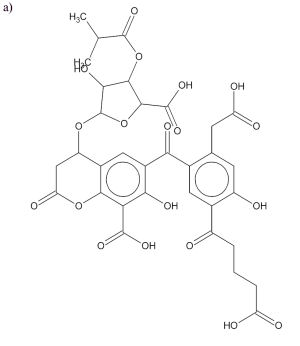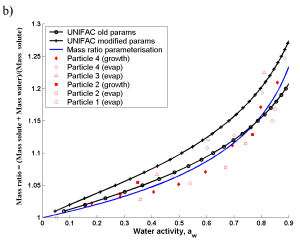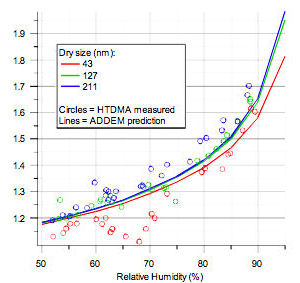Aerosol Water Content


Figure 1. Example of modelled versus measured water activity ('effective' concentration) for highly detailed organic chemical representation based on continental studies using UNIFAC (reproduced from Topping et al. 2005b). (a) Example of a proposed model structure of Suwanee River Fulvic Acid, used as a surrogate for humic like material in continental environments. (b) Mass ratio of Suwanee River Fulvic Acid, experimental data versus theoretical results. This includes single particle growth and evaporation data (evap/growth) and a mass ratio parameterization, derived from this data. The UNIFAC lines indicate use of the original UNIFAC equations with old binary interaction parameters and recently modified binary parameters between the OH, COOH and H2O groups. Picture taken from Topping et al. (2005b).
The interaction between aerosols and water vapour plays a large role in determining their effect on the environment. Particles with a high water affinity will take up moisture in high humidity conditions, increasing their size and in turn increasing their ability to scatter light and their single scattering albedo, with the associated effects on the radiative budget. After deliquescence, water uptake is governed by condensation and maintenance of thermodynamic equilibrium. As the RH increases further a maximum super-saturation of water vapour is reached where water molecules continue to condense on the droplet in an unstable state. At this point the aerosol is said to have been activated into a cloud droplet and starts growing rapidly. Importantly, some of the most important uncertainties in current modeling tools are in parameters dictating aerosol water content which is necessary for predicting the direct and indirect climatic effect. Additionally, an increase in the physical size of the particles will increase the surface area presented to the gas phase, which will in- crease the rate at which gas phase reactants are absorbed into it. Unfortunately, the chemical and physical characteristics of aerosols are diverse and attempting to encompass such variability within a hygroscopic model is complex.
At Manchester, tools have been developed which utilize detailed chemical information to predict water uptake both below and above 100%RH. Relying on detailed fundamental properties, the model ADDEM (Aerosol Diameter Dependent Equilibrium Model – Topping et al. 2005a,b), designed primarily for analysing hygroscopic growth in the sub-saturated humid environment, has enabled closure between field and laboratory studies on a level of complexity not previously available (figure 1). Parallel investigations on fundamental properties are used to improve model skill, including predictions of water uptake (link to Murrays stuff on vapour pressure/surface tension/water activity). Reduced complexity frameworks are required in large-scale models due to restrictions on computational cost. Elegant methods used to link growth below and above 100% RH by neglecting compositional information are now commonly used throughout the atmospheric community. Using a broad suite of instrumentation and detailed modeling tools described above, we are now able to use these models of vastly differing complexity to probe which processes may or may not be important and require further investigations (e.g. Good et al 2010). Importantly, the tools developed at Manchester enable consideration of detailed chemical information which, combined with appropriate closure studies in the field or laboratory, encourage development of robust parameterizations.

At Manchester we measure the hygroscopic growth of aerosol using a Hygroscopic Tandem Differential Mobility Analayser (H-TDMA). The HTDMA is composed of two Differential MobilityAnalysers (DMA), a particle counter, and various pumps and humidity control devices etc. A polydisperse aerosol distribution at ambient relative humidity enters the system, and is dried as it enters DMA-1 (RH < 10%). DMA-1 is used to select a monodisperse distribution of a given size. Aerosol exiting DMA-1 is humidified and then enters DMA-2 (which also has humidified sheath air). DMA-2 coupled with the particle counter is used to measure the size distribution of the humidified 'monodisperse' aerosol, hence providing a growth factor spectrum. The HTDMA has two modes of operation – constant humidity and varying humidity. In constant humidity mode, a given dry size is selected using the first DMA, then this aerosol is humidified to 90% RH, and the resulting distribution measured with the second DMA. Thus the growth factor/s of this aerosol size is obtained. Different dry sizes are selected in turn to build up a size resolved set of growth factors for the aerosol distribution. In varying humidity mode, a single dry size is selected, and the humidity of the second DMA is increased in steps from about 30 – 90%, and for each step the humidified distribution measured. Thus a humidogram for the selected aerosol size is produced. Cloud activation potential is measured using a cloud condensation nucleus counter (CCNc). (I don’t feel best placed to describe this in any more detail….Dave.).
References:
Allan et al 2009, Atmos. Chem. Phys., 9, 9299-9314
Good, et al 2009 Atmos. Chem. Phys. Discuss., 9, 22659-22692
Topping et al. 2005a, Atmos. Chem. Phys., 5, 1205-1222
Topping et al. 2005b, Atmos. Chem. Phys., 5, 1223-1242